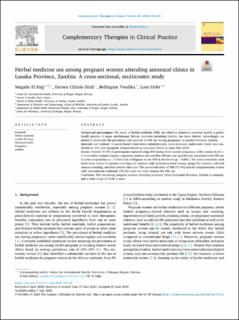| dc.contributor.author | el Hajj, Magalie | |
| dc.contributor.author | Sitali, Doreen Chilolo | |
| dc.contributor.author | Vwalika, Bellington | |
| dc.contributor.author | Holst, Lone | |
| dc.date.accessioned | 2021-07-15T09:30:06Z | |
| dc.date.available | 2021-07-15T09:30:06Z | |
| dc.date.created | 2020-08-24T14:03:05Z | |
| dc.date.issued | 2020 | |
| dc.identifier.issn | 1744-3881 | |
| dc.identifier.uri | https://hdl.handle.net/11250/2764485 | |
| dc.description.abstract | Background and purpose: The study of herbal medicine (HM) use which is related to maternal health, a public health priority in many sub-Saharan African countries including Zambia, has been limited. Accordingly, we aimed to determine the prevalence and patterns of HM use during pregnancy in Lusaka Province, Zambia.
Materials and methods: A survey-based (interviewer-administered), cross-sectional, multicentre study was conducted in 446 adult pregnant women attending antenatal clinics in June/July 2019.
Results: Overall, 57.8% of participants reported using HM during their current pregnancy, with a mean of 2.0 ± 1.5 remedies/woman. Logistic regression analysis showed that HM use was significantly associated with HM use in prior pregnancies (p < 0.001) and willingness to use HM in the future (p < 0.001). The most commonly used herbs were lemon for nausea/vomiting and common cold, soybean to boost energy, ginger for common cold and nausea/vomiting, and Aloe vera for skin care. The perceived safety of HM (37.6%) and its complementary action with conventional medicines (35.3%) were the main reasons for HM use.
Conclusion: HM use among pregnant women attending antenatal clinics in Lusaka Province, Zambia is common, and a wide range of herbs is used. | en_US |
| dc.language.iso | eng | en_US |
| dc.publisher | Elsevier | en_US |
| dc.rights | Navngivelse 4.0 Internasjonal | * |
| dc.rights.uri | http://creativecommons.org/licenses/by/4.0/deed.no | * |
| dc.title | Herbal medicine use among pregnant women attending antenatal clinics in Lusaka Province, Zambia: A cross-sectional, multicentre study | en_US |
| dc.type | Journal article | en_US |
| dc.type | Peer reviewed | en_US |
| dc.description.version | publishedVersion | en_US |
| dc.rights.holder | Copyright 2020 the authors | en_US |
| dc.source.articlenumber | 101218 | en_US |
| cristin.ispublished | true | |
| cristin.fulltext | original | |
| cristin.qualitycode | 1 | |
| dc.identifier.doi | 10.1016/j.ctcp.2020.101218 | |
| dc.identifier.cristin | 1824828 | |
| dc.source.journal | Complementary Therapies in Clinical Practice | en_US |
| dc.identifier.citation | Complementary Therapies in Clinical Practice. 2020, 40, 101218. | en_US |
| dc.source.volume | 40 | en_US |

